After months of secrecy, BMW Oracle Racing launched their enormous 90-foot multihull yacht in September and started sailing it very publicly in Anacortes, Washington State. Even by today's high standards, it is an impressive and unique machine, and Russell Coutts's sailors are extremely excited to be sailing it after so many months in the making.
Australian helmsman James Spithill is a match racing monohull sailor by trade - seen by some as the heir apparent to Coutts himself - but in the game of big multihull sailing he admits he is a wide-eyed rookie. He spoke to Boat International about what it's like to sail this leviathan.
"It's a pretty amazing experience, not only for us but for Franck [Cammas] and his guys, even though they're used to multihulls." Cammas and his French colleagues have been hired from the very experienced Groupama multihull racing team, whose own giant trimaran Groupama III broke up during their non-stop round-the-world record attempt last winter. "The mast height is something none of us is used to," says Spithill. "When I looked up at it the first day we went sailing, I thought ‘God, we've got it wrong!' But even after two weeks of training it doesn't seem as big any more. It's surprising how quickly you can get used to things."
Spithill says they've been very cautious in loading up the boat bit by bit. They've sailed the 90-footer to nothing like its potential yet. In fact they're not sure where the potential ends. The learning curve will be steep for some months to come.
They dare not push the boat too hard too soon. A capsize would be catastrophic, most likely resulting in a broken boat and almost certainly broken limbs. Spithill has capsized the Extreme 40 catamaran twice this year, although as he laughingly points out, that makes him even with Franck Cammas, also on two capsizes this season - or three if you count the life-threatening capsize of the broken Groupama 3 in the Southern Ocean, when his team was airlifted to safety by the New Zealand rescue services.
Capsizing is a man-made hazard, but there are other naturally occurring hazards for a boat that moves with such power and speed. "Before we started sailing the boat out of Anacortes, we took a helicopter ride to look for whales, and we counted at least 12 killer whales in the space of half an hour. There are also quite a few logs in the water, and initially we were quite worried about sailing the boat there. So we always had a powerboat riding about 100 metres in front of us, and they could radio back to us if anything was in our way. That would just about give us time to take avoiding action, hopefully!"
So, down to brass tacks. How fast is this thing? "Well we've been very conservative so far, but the top speed has been around 30 knots, in about 10 to 12 knots of wind." What? Almost three times the windspeed? "We've not even come close to seeing the thing at full performance, but it's worth remembering that the fastest point for these boats is when they're heavily reefed, with a reduced mainsail and just a solent or a staysail at the front. You've just got to reef a boat like this, so I think one of the key skills on the America's Cup track is how effectively you can reef up and reef down for different legs of the course."
Initially Cammas did all the steering in the first few days, but eventually Spithill got his go at the wheel, right at the back of the beam and quite far outboard. "It's an amazing boat to steer, a lot more responsive than I thought it would feel. I was expecting it to feel heavy. The position of the helmsman is pretty interesting, quite far back and very high over the water, which allows you to see the floats very clearly. The big thing I've noticed is that compared with monohulls when you're very reliant on the numbers and the instruments, with this boat you're looking out at the water ahead of you a lot more, trying to predict where the gust will hit you." Because the boat is travelling faster than windspeed nearly all the time, spotting the breeze downwind can be tricky, as you're catching up the gusts in front of you. "It means you're in a wind tunnel for the entire day, which is not great for someone like me with my convict-heritage skin! But everyone is wearing a helmet and a lifejacket. We're not taking any unnecessary risks."
While being a few months behind BMW Oracle in terms of completing their own multihull, Alinghi do hold an ace card of being able to nominate a venue of their choosing. BMW Oracle have been forced to build a boat that will be capable of racing in almost any wind condition. "We have no idea where the venue will be and it's certainly a card they hold," admits Spithill, who says Alinghi team members have been in Anacortes on recce missions to learn more about the big BMW beast. Franck Profitt - Alinghi's answer to Cammas - has been in town, as has Tom Schnackenburg, with whom Spithill was team mates at Luna Rossa for the last Cup.
Spithill is not concerned about what Alinghi have or haven't seen of the boat. "I had a beer with Schnack the other night, he's a good mate, just like many of the guys on that team. It would be great to see two of these boats go up against each other." As to optimising a boat for a particular venue, Spithill thinks you'd have to be very careful going to far. "It's difficult. With Valencia, every year was different. One summer was windy and another one was light, so even though you get a bit of an idea, it's not guaranteed."
Then again it's not guaranteed that these two giant multihulls will ever race in anger. There is plenty of legal battle to be done before we know what will become of these boats. Spithill the sailor is not concerning himself with such ‘ifs' and ‘buts'. "All we can do from a sailing team's point of view is be ready to race. We've been amazed at this multihull world, it really is a different world to what we're used to, and it's been great fun learning about it. We believe we've got a solid case in the court room, but our job as sailors is to understand this boat and get it up to speed."
So having burned up the track this year in Extreme 40s, Open 60s and now this 90-footer, can Spithill ever envisage going back to an America's Cup in boring old keelboats? "We've had so much fun sailing these things, it wouldn't just be hard going back to a monohull America's Cup, it's going to be hard going back to ocean racing monohulls too. But with the Cup, the logistics, the type of racing we do, you get bow on stern action, you get head to head racing in keelboats. You just don't get that in multihull racing, at least that's what we've seen when we've raced the Open 60s against each other."
The lack of boat-on-boat action will be even more pronounced in the 90-footers. "Every time you have to turn a corner, the boat completely stops. In a 60 we'd lose 80 to 100 metres every tack. In this boat it will be a lot more. From that point of view it's a completely different racing emphasis. We'll need good navigation software for calling the laylines."
After a successful two weeks in Anacortes, the team now moves to San Diego for two months' training in October and November further south in the warmer waters of San Diego. "It's quite landlocked by the islands in Anacortes, so not will it be warmer, but this will be the first chance to sail the boat on open water and really see what it can do," says Spithill.
Louis Vuitton Pacific Series
Meanwhile the other potential challenger teams who have been kicking their heels this past year finally have a new regatta to get their teeth into. The Louis Vuitton Pacific Series will invite America's Cup teams to come and race in the old Version 5 boats in Auckland early next year. Interesting to note that Louis Vuitton has put its name to the event, a corporate two-fingered salute to Alinghi if ever there was one, having withdrawn its longstanding support from the Cup after the end of the 32nd edition last year. It suggests that one day perhaps Louis Vuitton will return to the Cup, but probably not while Alinghi is in charge.
Russell Coutts said that BMW Oracle would be entering the event, and was quick to acknowledge Louis Vuitton's involvement. "It is really good to see Louis Vuitton leading this initiative, and we are really looking forward to coming to Auckland to join in what I'm sure will be a great competition. Congratulations are also due to the New Zealand Government, Emirates Team New Zealand and the other partners to the event in coming up with this format. This is a great way to get everyone back on the water. Auckland is always a great place to sail. And with a race format aimed at close competition this will be an event that sailors and fans will really enjoy."
Olin Stephens 1908 - 2008
Olin J. Stephens, the most prolific and well known designer in the America's Cup, passed away in September. He designed the winners of a total of eight of the nine America's Cup matches between 1937 and 1980. Stephens was an innovator, and is widely credited for specifying a separate rudder from the keel on large racing yachts where the norm had been to have a rudder as an integral part of the keel. As well as having an eye for a fast boat, Stephens was equally interested in improving the safety of ocean-going yachts. "Some modern ocean racers, and the cruising boats derived from them, are dangerous to their crews," was his controversial observation after the fateful Fastnet Race in 1979, and this led him to carry out some in-depth research into the causes of capsizes by keelboats. Stephens' legacy is to have made yachts not only faster, but safer too.
-- New York Yacht Club
From John Rousmaniere:
One of Stephens's concerns was the seaworthiness of contemporary boats, many of which he thought too beamy, high-sided, light and unstable. After the 1979 Fastnet Race storm left a trail of capsized boats and 15 dead, Stephens wrote the shocking statement, In the early 1980s he helped direct a sophisticated study of the causes of capsizes by keel boats that was co-sponsored by the United States Yacht Racing Union and the Society of Naval Architects and Marine Engineers. Out of this work came several reports and a book, "Desirable and Undesirable Characteristics of Offshore Yachts," to which Stephens contributed two articles.
All this time Stephens was producing successful racing boats, including the winners of a total of eight of the nine America's Cup matches between 1937 and 1980. Other than Ranger, the most remarkable of these boats was Intrepid, the defender in 1967 and, after alterations by Britton Chance Jr., again in 1970. She had a rudder separate from her keel to reduce wetted surface and improve steering. The separate rudder was not new, but Stephens made it work on a number of increasingly large ocean racers (most notably Thomas Watson's Palawan) in the mid-60's before successfully using it on Intrepid.

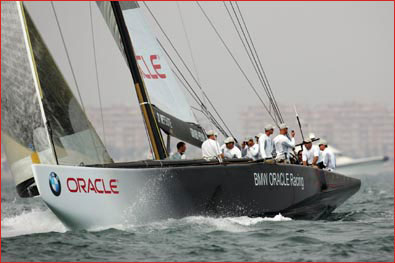 BMW Oracle has been carrying out some extensive TV trials of monohulls and multihulls in Valencia. The aim, says the Defender, is to work out which kind of boat is going to offer the biggest bang for buck in Russell Coutts’s vision of a more media-friendly and commercially-attractive America’s Cup...
BMW Oracle has been carrying out some extensive TV trials of monohulls and multihulls in Valencia. The aim, says the Defender, is to work out which kind of boat is going to offer the biggest bang for buck in Russell Coutts’s vision of a more media-friendly and commercially-attractive America’s Cup...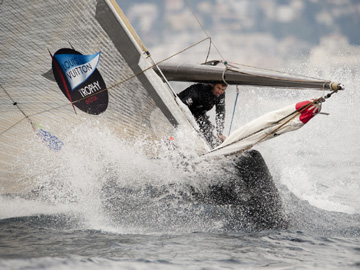 Louis Vuitton has been an integral part of the America’s Cup since the luxury goods company first gave its name to the Louis Vuitton Challenger Series back in Newport 1983. That close association continued up to Valencia 2007, but following Alinghi’s successful defence of the Cup, Louis Vuitton withdrew its backing...
Louis Vuitton has been an integral part of the America’s Cup since the luxury goods company first gave its name to the Louis Vuitton Challenger Series back in Newport 1983. That close association continued up to Valencia 2007, but following Alinghi’s successful defence of the Cup, Louis Vuitton withdrew its backing...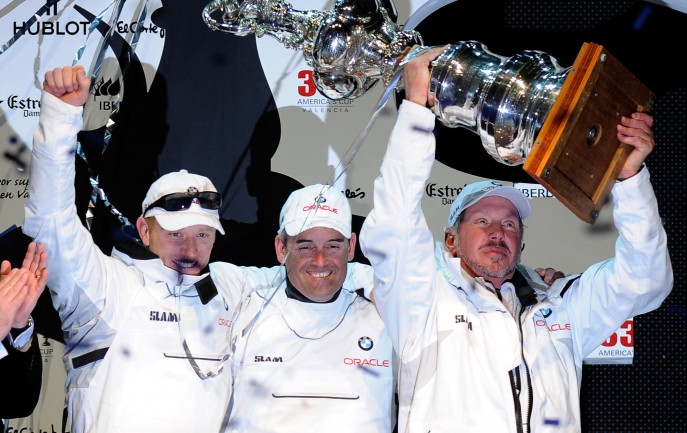 So now we’ve seen the power of wing rigs in action in the America’s Cup, what possibility of a trickledown of technology into other forms of sailing? What about superyachts? BMW Oracle’s design team director Mike Drummond observed, tongue in cheek: “If you go to Wings R Us.com, you can get any size you like.” Of course, this technology is anything but off the shelf, but nor is it new, as Drummond also pointed out: “Wings are not new, they’ve been used by birds for quite a long time...
So now we’ve seen the power of wing rigs in action in the America’s Cup, what possibility of a trickledown of technology into other forms of sailing? What about superyachts? BMW Oracle’s design team director Mike Drummond observed, tongue in cheek: “If you go to Wings R Us.com, you can get any size you like.” Of course, this technology is anything but off the shelf, but nor is it new, as Drummond also pointed out: “Wings are not new, they’ve been used by birds for quite a long time...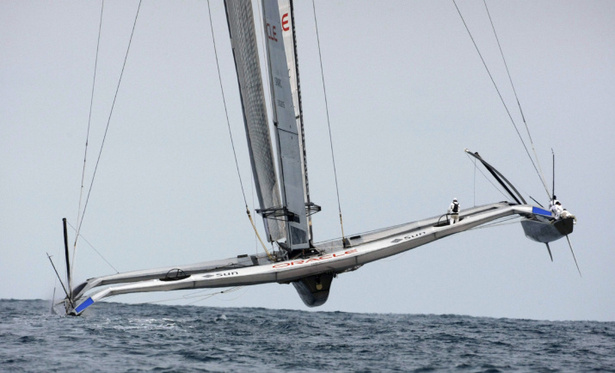 So now we know. Wings trump sails. Theory has always stated that a wing rig should be faster than conventional sails. But the challenge was actually to put a wing rig into practice, to be able to build it in less than six months, and also to manage the logistics of it...
So now we know. Wings trump sails. Theory has always stated that a wing rig should be faster than conventional sails. But the challenge was actually to put a wing rig into practice, to be able to build it in less than six months, and also to manage the logistics of it...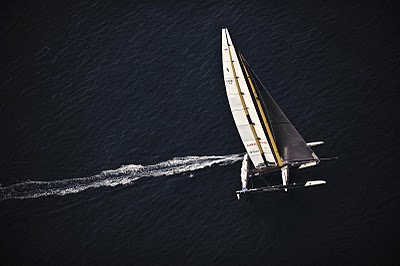 Race 2 was set to take place two days later on the Sunday. It was another long wait while Harold Bennett looked for suitable conditions in which to start the race. The cut-off time of 4pm was just minutes away when Bennett called for the start procedure to begin...
Race 2 was set to take place two days later on the Sunday. It was another long wait while Harold Bennett looked for suitable conditions in which to start the race. The cut-off time of 4pm was just minutes away when Bennett called for the start procedure to begin...